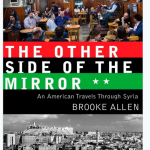 Brooke Allen closes her entertaining travelogue about two trips she took to Syria with a quote from Mark Twain: “Travel is fatal to prejudice, bigotry, and narrow-mindedness.” At a time when many Americans view Arab lands in the middle East as monolithic bastions of Sharia law that succor terrorists, she and her husband (who is Jewish) took their two teenaged daughters on a trip to see the sights of Syria. (Allen went back on a subsequent trip with two adult friends.) And as she describes it, Syria is worth the trip.
Brooke Allen closes her entertaining travelogue about two trips she took to Syria with a quote from Mark Twain: “Travel is fatal to prejudice, bigotry, and narrow-mindedness.” At a time when many Americans view Arab lands in the middle East as monolithic bastions of Sharia law that succor terrorists, she and her husband (who is Jewish) took their two teenaged daughters on a trip to see the sights of Syria. (Allen went back on a subsequent trip with two adult friends.) And as she describes it, Syria is worth the trip.
A crossroads of trade (the Silk Road harbors were in greater Syria) and religion (four major western faiths were followed here more or less from their beginnings), Syria was at the center of the ancient and medieval worlds. Damascus has been continuously inhabited for centuries, Allen reports. Other sites were built on, successively, by Jews, Romans, Crusaders, Byzantines, Ottomans. Tamerlane and Saladin built strongholds there. Some were destroyed by attacking Mongols. All of them left sights to see.
Allen divides her book into six overlapping sections that she uses to build an outline of Syria’s history and culture. “Leaders,” which briefly describes the Assads and their rule, comes last. Earlier, Allen describes the geopolitical reasons the Assads are in power. She notes also that “asad” means lion in Arabic; lions are a widespread decorative motif throughout Syria, giving the Assads obvious symbolic opportunities. Allen no more foresaw the Arabic Spring than did anyone else, and so her book does not address the unrest of 2011 (but see the excellent blog Syria Comment for up-to-date information).
The section “Ruins” opens and closes with hotel descriptions; there were some grand ones, and some grand visitors, including kings and queens as well as Patrick Leigh Fermor and T.E. Lawrence. There are ruins upon ruins, some still occupied, many still unearthed. And there is a long history of religious tolerance. Allen describes how archeologists have found, in one small area in Dura, pagan temples, temples to Palmyrene gods, a Christian house church (dating from the third century, it’s the oldest in Syria, from a time when Christianity was still an underground religion), and an ancient Jewish temple with painting after painting of Old Testament scenes, unique in Jewish history because of the proscription against graven images. A temple to Mithra, a Persian divinity, also emerged. Allen calls the juxtaposition characteristic of Syria, “[h]ere in this not-very-large community four religious systems existed simultaneously and apparently in harmony: the pagan, the Mithraic, the Judaic, and the Christian.”
Faith is by far the longest section: Syria was Jewish and Christian before the arrival of Islam, when it became a jumping off point for the Haj. The home also of many minor faiths and schismatic slivers of major ones, Syria remains a secular country today. Allen intersperses history, ancient and modern, including the sad history of the French mandate that arose once the victorious Western powers carved up the former Ottoman Empire after the end of the First World War. Syria’s location has meant many waves of refugees: Palestinians arrived in the wake of the Crusaders; Armenians came from Turkey after 1915; Iraqis have arrived in great numbers in the last decade. That description underlines one of Allen’s main points: religious syncretism in Syria has led to an open, diverse society (as long as its inhabitants are willing to leave politics to the few) that is welcoming to outsiders.
Now is probably not the best time to plan a trip to Syria, tempting though this book makes the prospect. In the meantime, the Met’s new Galleries for the Art of the Arab Lands, Turkey, Iran, Central Asia, and Later South Asia make a pretty good substitute. And then take a trip to Tanoreen in Bay Ridge for the food. Tell us your favorite local Middle Eastern restaurants and cultural centers in the comments.
Update, December 20: NYU’s Institute for the Study of the Ancient World, 15 E. 84th St, has an exhibit about Dura, “Edge of Empires: Pagans, Jews and Christians at Roman Dura-Europos” through January 8. The New York Times article about the exhibit is here.
Have a book you want me to know about? Email me at asbowie@gmail.com. I also blog about metrics at asbowie.blogspot.com.
